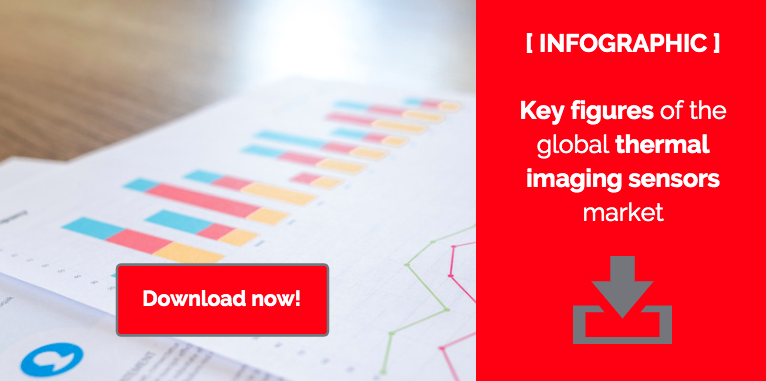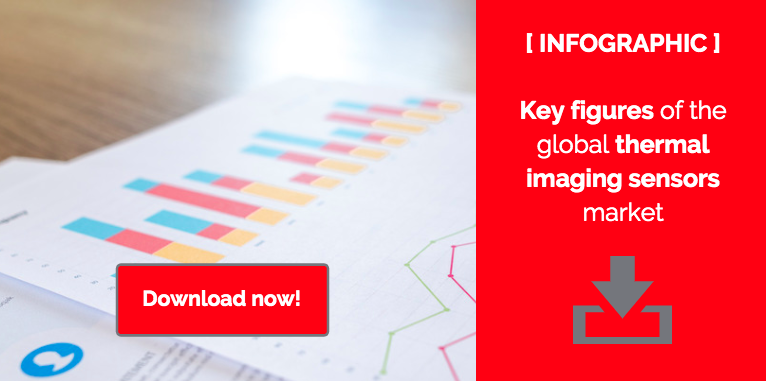Originally a military technology, thermal imaging has advanced considerably over the years, finding applications in a broad range of situations. Today, thermal imaging is used in industry, buildings, and leisure—and it has even made its way into our homes!
The thermal imaging market is growing steadily. This article provides a brief analysis of the current market.
- A good geographical balance
For several decades the United States dominated the global market with the support of major research and development programs run by DARPA (Defense Advanced Research Projects Agency). Today, however, the global market is more balanced, with the US representing around 54% of the market by value vs. 46% for the rest of the world.
- A dense constellation of well-established market players
The thermal imaging market is dominated by well-established market players who leverage partnerships, joint projects, acquisitions, new product developments, product launches, and other agreements to increase their share of the global thermal imaging market. In 2017 the market saw around 20 mergers and acquisitions.
Some of the market leaders are: Flir Systems, Bae Systems, Leonardo DRS, L3, ULIS, Lockheed Martin, Elbit Systems, Raytheon, Sofradir, Jenoptik, Safran, Thales, Guide Infrared, and Zhejiang Dali.
- Different countries, different regulatory landscapes
Different countries have different rules for importing and exporting thermal imaging sensors. This is a major issue that must be taken into consideration.
In 1996, 33 countries signed the Wassenaar Arrangement on Export Controls for Conventional Arms and Dual-Use Goods and Technologies to coordinate their export policies. Dual-use goods are considered sensitive in that they can be used not only for their original civil applications, but for military applications as well.
In the United States, thermal imagers and their components may be subject to ITAR (International Traffic in Arms Regulations), enforced by the US Department of Defense, or EAR (Export Administration Regulations), enforced by the US Department of Commerce. These regulations require the identification of the final Recipient which can create challenges when selling through distributors. However, the real issue surrounding the US regulations is that they are extra-territorial, which means that they must also be followed by companies outside the US.
The vast majority of infrared cameras contain at least one US-made component. Therefore, these cameras are subject to the US regulations, giving the United States the ability to restrict export sales of these cameras to other countries. Many European manufacturers use US-made electronic components in their products, especially in the aeronautics and space industries.
For this reason, it can be advantageous to use components not manufactured in the US, as they are not subject to the US regulations. This could bring real business opportunities to component manufacturers outside the US.

- Defense and national security remain the main market drivers
Political instability in certain parts of the world and the rise of terrorism have spurred governments around the world to make sure that their armed and police forces have the latest equipment. Advances in thermal imaging sensors have given rise to high-performance, lightweight portable equipment with longer battery life.
According to different sources, the compound annual growth rate of the thermal imaging market is somewhere between 8% and 10% for defense and between 10% and 20% for surveillance.
- Strong growth on emerging markets
The global thermal imaging market is expected to grow by 7.18% from 2018 to 2023 (from $5.16 billion to $7.3 billion). The Asia-Pacific region should be a major growth driver with strong demand from the security industry.
In terms of applications, the increasing integration of thermal cameras into connected devices and smartphones plus high demand for surveillance and security cameras with higher and higher resolutions (especially in the defense industry) will create many opportunities.
The market is fast-paced and the competition is fierce. Therefore, opportunities like winning market share in the Asia-Pacific region, innovating new applications for SWIR cameras, and penetrating the consumer electronics industry cannot be missed.
In this landscape, the challenges will be to bring prices down and offer greater performance and more compact form factors.
And 2018 is not over yet! The year could still bring some nice surprises that will make the market outlook even more optimistic.
To learn more, download our free infographic with the latest global thermal imaging market data.

(source: « the world market for commercial & dual-use infrared imaging & infrared themometry » Maxtech international, Inc – 2018)











